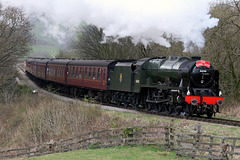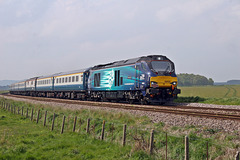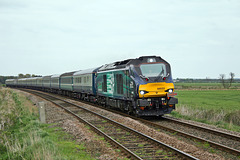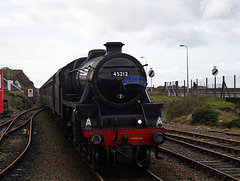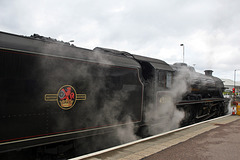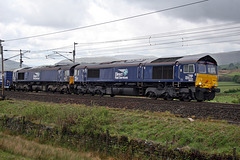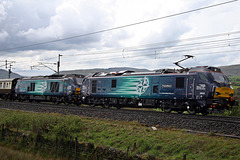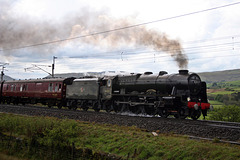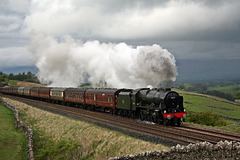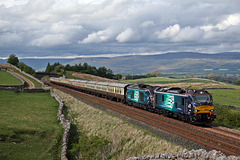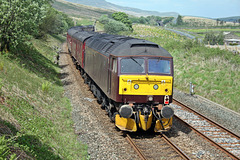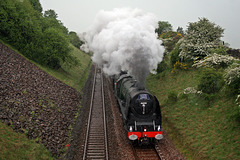
Rail Transport
LMS class 5 45212 climbing away from Grosmont with…
| |
|
|
|
LMS Royal scot class 46100 ROYAL SCOT at Esk Viadu…
| |
|
|
|
The original 6100 was the first of its class, built in 1927 by the North British Locomotive Company in Glasgow. It was named Royal Scot after the Royal Scots.
In 1933, 6152 The King's Dragoon Guardsman and 6100 swapped identities permanently. 6152 had been built at Derby Works in 1930. The new Royal Scot was sent to the Century of Progress Exposition of 1933 and toured Canada and the United States with a train of typical LMS carriages.
It was given special commemorative plates that sit below its nameplates which read:
This locomotive with the Royal Scot train was exhibited at the Century of Progress
Exposition Chicago 1933, and made a tour of the Dominion of Canada and the United
States of America. The engine and train covered 11,194 miles over the railroads
of the North American continent and was inspected by 3,021,601 people.
W. Gilbertson - Driver T. Blackett - Fireman
J. Jackson - Fireman W.C. Woods - Fitter
6100 was renumbered 46100 by British Railways after nationalisation in 1948. In 1950 46100 was rebuilt with a 2A taper boiler, and the words "Prior to conversion" were added to its nameplates. It became a markedly different engine. In October 1962 46100 was withdrawn from service in Nottingham.
46100 was bought by Billy Butlin of Butlins holiday camps after withdrawal and after cosmetic restoration into LMS crimson lake at Crewe Works, although this was the original livery received, the locomotive did not carry it after being rebuilt (only one rebuilt Royal Scot ever carried LMS crimson lake livery and that was 6170 Royal British Legion). It was then towed from Crewe Works to Nottingham by Black 5 No. 45038 and then from Nottingham to Boston by B1 No. 61177 on 12 June 1963.
After spending a few days at Boston shed it was taken to Skegness by an Ivatt 4MT, it languishing in the goods yard for 3 weeks before being taken by a Pickford's low loader for the short road trip to Ingoldmells.
Royal Scot arrived at Butlins on 18 July 1963 piped in by pipers from the 1st Battalion, The Royal Scots. This made 6100 one of two preserved rebuilt Royal Scots, the other being 6115 Scots Guardsman. It was set on a plinth at Skegness and was to remain there till the 1970s. On 16 March 1971 6100 departed from Skegness for the Bressingham Steam Museum and was returned to steam in 1972. It ran until 1978 when it once more became a static exhibit, it was eventually sold from Butlins to Bressingham in May 1989.
After sale to the Royal Scot Locomotive and General Trust (RSL>) in April 2009, chaired by enthusiast Jeremy Hosking, it was moved by road to Pete Waterman's LNWR Heritage workshops in Crewe.
On 20 March 2009, Royal Scot caught fire en route to a steam gala at the West Somerset Railway. The locomotive was being transported along the M5 Motorway when a fire started on the lorry under the loco's leading wheels.The engine was later withdrawn from service due to a number of mechanical problems after completion from its previous restoration and it was decided to give the engine a complete overhaul to mainline standards.[citation needed]
She performed her light and loaded test runs on Tue 22 & Wed 23 December 2015 and worked her debut railtour on Sat 6 February 2016.
LMS class 5 44806 climbing from Grosmont up to Esk…
| |
|
|
|
DRS class 68 68022 RESOLUTION with 1Z68 Pathfinder…
| |
|
|
|
The Class 68 is a type of mainline mixed traffic diesel-electric locomotive manufactured by Vossloh for Direct Rail Services in the United Kingdom. The design is derived from the Vossloh Eurolight, and Vossloh's product name is UK Light.
The second batch of Class 68s - also for Direct Rail Services - completed delivery in April 2016.
DRS class 68 68022 RESOLUTION on the returning 1Z6…
| |
|
|
|
LMS class 5MT 45212 arrives at Mallaig with the Ja…
| |
|
|
|
The London Midland and Scottish Railway Class 5 4-6-0, almost universally known as the Black Five, is a class of steam locomotive. It was introduced by William Stanier in 1934 and 842 were built between then and 1951. Members of the class survived to the last day of steam on British Railways in 1968, and eighteen are preserved. This class of locomotive was often a favourite amongst drivers and railway fans.
The Black Fives were a mixed traffic locomotive, a "do-anything go-anywhere" type, designed by Stanier, who had previously been with the GWR. In his early LMS days, he designed his Stanier Mogul 2-6-0 in which he experimented with the GWR school of thought on locomotive design. A number of details in this design he would never use again realising the superiority of details not used on the GWR. Stanier realised that there was a need for larger locomotives. These were to be the LMS version of the GWR Halls but not a copy, as the Hall was too wide to run most places in Britain. They shared similar cylinder arrangement (two outside), internal boiler design and size and 6 foot driving wheel diameters.
In their early days the locomotives were known as the "Black Staniers" from their black livery, in contrast to Stanier's other class of 4-6-0, the LMS Stanier Jubilee Class, which were painted crimson (and known until April 1935 as the "Red Staniers"). Later on, the nickname of the former became "Black Five", the number referring to the power classification. This was originally 5P5F, but from 1940 was shown on cabsides as the simple figure 5
There were a number of detail variations in the locomotives and they did not all remain in the same condition as built. Some locomotives built under British Railways administration were used as test beds for various design modifications with a view to incorporating the successful modifications in the Standard Classes of locomotives built from 1951 onwards. These modifications included outside Caprotti valve gear, roller bearings (both Timken and Skefco types) on the coupled and tender axles in varying combinations, and an experimental steel firebox. Other locomotives had modified draughting to "self clean" the smokebox (thereby reducing turn-around and disposal times and eliminating or mitigating one of the most unpopular jobs).
Only five Black Fives received names during their mainline working lives, a small percentage of the total produced, although seven more have been named in preservation (see below). All of those named in mainline service were named after Scottish regiments. Locomotive 5155 carried the name The Queen's Edinburgh for only two years during the Second World War. Some sources have noted that no photographic confirmation of this naming is extant, although this is neither unique to the class, nor unexpected given restrictions on photography during wartime. The evidence for the naming of the locomotive is set out in full in various sources.
LMS No. BR No. Name Date named Name removed
5154 45154 Lanarkshire Yeomanry 1937 1966 (withdrawal from service)
5155 45155 The Queen's Edinburgh 1942 1944 (remained in service until 1964)
5156 45156 Ayrshire Yeomanry 1936 1968 (withdrawal from service)
5157 45157 The Glasgow Highlander 1936 1962 (withdrawal from service)
5158 45158 Glasgow Yeomanry 1936 1964 (withdrawal from service)
Eighteen black 5's have been preserved with twelve of them being purchased directly from BR for preservation, the remaining six being rescued from Barry Scrapyard. Of the eighteen to be preserved fourteen have operated in preservation, the class members that haven't yet run being: 44901, 45163, 45293 & 45491. Twelve black fives have also been operated on the mainline in preservation: 44767, 44871, 44932, 45000, 45025, 45110, 45212, 45231, 45305, 45337, 45407 & 45428.
Of these 44871, 45212, 45231, 45305 & 45407 have mainline certificates. 45212 went out on Fri 3 March for its light and loaded test runs, 45428 is to be re-certified for mainline use following the completion of an overhaul at Grosmont, 45428 will however only be certified for use between Grosmont and Whitby with Battersby occasionally visited & 44806 is to be mainline certified for use between Grosmont, Whitby & Battersby following her next overhaul.
LMS class 5MT 45212 stands at Mallaig after arrivi…
| |
|
|
|
LMS class 5 45212 running round its Train at Malla…
| |
|
0010. DRS class 66`s 66431+66429 at Scout Green wi…
| |
|
|
New DRS class 88 88002 PROMETHEUS +68025 SUPERB at…
| |
|
|
|
The Class 88 is a type of mixed traffic electro-diesel locomotive manufactured by Stadler Rail for Direct Rail Services in the United Kingdom. The design is part of the Stadler Euro Dual family.
In January 2012, Direct Rail Services announced that it had ordered a total of 15 new diesel locomotives from Vossloh (now Stadler Rail). These locomotives, which entered service in the UK as Class 68, were part of Vossloh's Eurolight family, redesigned to fit the smaller UK loading gauge.
In September 2013, DRS announced that it was procuring a further ten locomotives. Unlike the Class 68s, these new units would be electro-diesel locomotives, capable of operating either via OHLE, or by using an onboard diesel engine. However, the new locomotives would feature the same bodyshell, cab, brakes, bogies, traction equipment and control software as the Class 68. The new locomotives were announced as being Class 88.
The first locomotive, no. 88 002, was delivered to the UK via the Port of Southampton and was transferred by road to Carlisle in January 2017.
The Class 88 is part of the Stadler Euro Dual family. This is a range of dual mode locomotives that are fitted both with a pantograph, to collect electricity from overhead wires, and a Caterpillar diesel engine. The UK version will be able to run either on electrified lines using the pantograph, which will be the UK's standard OHLE current at 25kV AC, or away from electrified lines with the Caterpillar C27 950 hp (710 kW) engine. Dual mode locomotives have been mooted for freight use in the UK, using the "Last Mile" principle, where a primarily electric locomotive is fitted with a small diesel engine to allow trains to be delivered to unelectrified freight sidings.However, the Class 88 is intended as a fully dual mode locomotive, with the diesel engine powerful enough to haul a train on its own, although with only 20% of the power in electric mode.The Class 88s will be the first dual mode locomotives in the UK to use the 25kV AC electrification, as the only other electro-diesel locomotives to have entered service on the British network were the Class 73 and Class 74, which operated in the Southern Region using third rail electrification.
Direct Rail Services has procured the Class 88 to serve as a mixed-traffic locomotive, capable of operating both passenger and freight services.[6] Primarily they will be used to enable DRS to haul freight using electric locomotives without the need to hire in electric traction from other operators.However, as with the Class 68, they will also be capable of operating passenger trains.
LMS class 7P Royal Scot 46115 SCOTS GUARDSMAN at S…
| |
|
|
|
LMS class 7P Royal Scot 46115 SCOTS GUARDSMAN at G…
| |
|
|
|
New DRS class 88 88002 PROMETHEUS + 68025 SUPERB a…
| |
|
|
|
West Coast Railways class 47 47760 on rear of 1Z32…
| |
|
|
|
GBRf class 66 66743 at Greengate near Kirkby Steph…
| |
|
|
|
LMS class 8P Coronation 46233 DUCHESS OF SUTHERLAN…
| |
|
|
|
LMS class 8P Coronation 46233 DUCHESS OF SUTHERLAN…
| |
|
|
|
LNER class A4 60009 UNION OF SOUTH AFRICA on test…
| |
|
|
|
Jump to top
RSS feed- Latest items - Subscribe to the latest items added to this album
- ipernity © 2007-2024
- Help & Contact
|
Club news
|
About ipernity
|
History |
ipernity Club & Prices |
Guide of good conduct
Donate | Group guidelines | Privacy policy | Terms of use | Statutes | In memoria -
Facebook
Twitter


